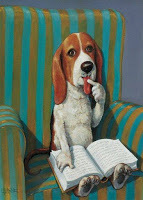Clancy Tucker's Blog, page 53
April 10, 2021
12 May 2021 - PAUL LUNG’S HYPER-REALISTIC ART

PAUL LUNG’S
HYPER-REALISTIC ART
G'day folks,
It is incredible to think how talented some artists are. When I came across the wonderful drawings of Paul Lung I was tricked into thinking that these images were black and white photographs. It is hard to believe that they were all drawn using a single pencil! Take a look at his accurate depiction of cats and people in this truly fascinating collection:

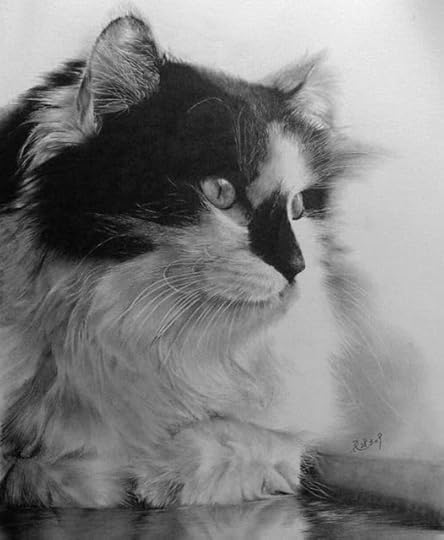

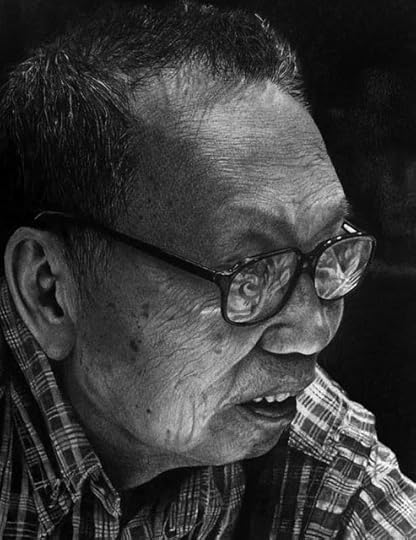
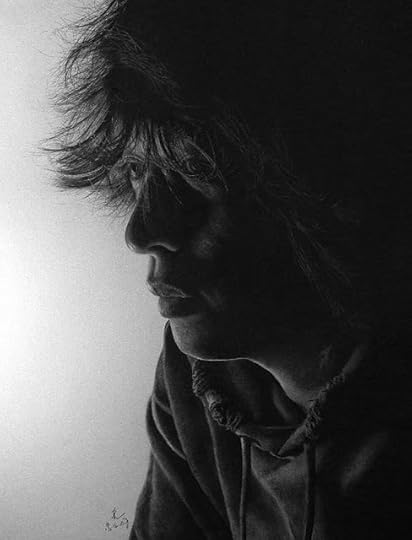
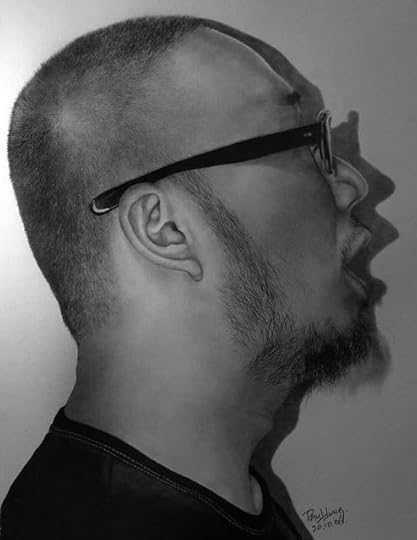

Clancy's comment: Extraordinary work. Sixty hours for each? Simply gob smacking.
I'm ...
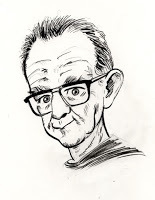

15 May 2021 - THOMAS EDISON – INVENTOR EXTRAORDINAIRE

THOMAS EDISON
– INVENTOR EXTRAORDINAIRE -
G'day folks,
February 11, 1847 — It took climate change to motivate the development of electric cars in the 21st Century, but Thomas Edison had been working on the same project about 120 years earlier.
The great inventor was convinced that cars should be powered by electricity rather than oil-based products and in 1899 he began to develop an alkaline storage battery that would power them. He planned to produce a battery that would run the car for 160 kilometres (100 miles) before it needed to be re-charged.
Edison worked on the project for about ten years then gave up because the abundant supply of cheap petrol made the dream redundant.
His efforts were not in vain, though. Storage batteries became his most profitable invention and his friend Henry Ford used them in his Model T cars. Variations of Edison’s storage batteries also had a number of uses, from railroad signals to the lamps in miners’ helmets.
In another modern-day Edison link, when running for the presidency Joe Biden asked in a Wisconsin speech: “Why in God's name don't we teach history in history classes? A black man invented the light bulb, not a white guy named Edison.”
He was probably referring to the black American inventor Lewis Howard Latimer who worked on development of both the light bulb and the telephone. But Mr Biden needs to have a word with his history teacher, for neither Thomas Edison nor Lewis Latimer created the light bulb, even though, as Mr Biden said, Edison’s name is most often associated with the invention.
The first person to show that electrically heated wires could give out light was 18th Century English scientist Humphry Davy. But a successful incandescent light needed a cheap material that burned brightly and was long-lasting, and Davy could not solve the problem. Nor could others who tried and failed. But Edison could and in 1879 he introduced his groundbreaking carbon filament light bulb based on Davy’s research.
Historians agree that Edison did not invent the electric light bulb, but he did produce the first commercially viable one.
It was just one achievement in the extraordinary life of a remarkable man who began work as a scientist in the 1860s at a time when low-voltage current from huge batteries was the only source of electrical power. When he died some 70 years later the modern age of electricity had been created, much of it by his guiding hand, and Edison was the holder of a world record 1,093 patents.
Thomas Alva Edison was born in Milan, Ohio, the seventh and last child of Samuel Edison Jr and his wife Nancy. Samuel drifted in and out of various jobs in his lifetime, from splitting shingles for roofs to keeping a tavern.
Unlike her husband, Nancy, a devout Presbyterian, had some formal education, which was soon put to good use.
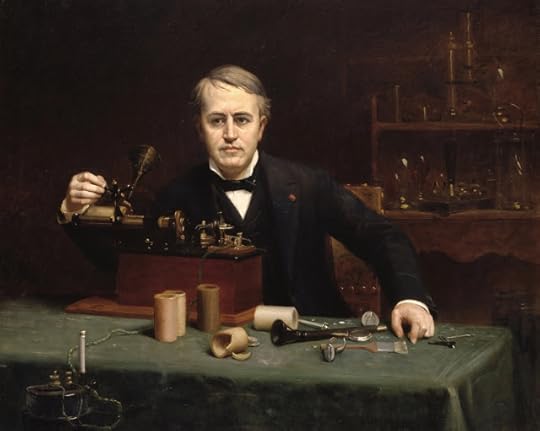
Thomas, known to his family as “Al”, struggled at school because he had developed hearing problems at an early age. In later life he was almost deaf. One teacher, considering him to be slow or dim, described him as “addled” – much to the fury of Nancy who decided to take the boy out of school and teach him herself at home.
Edison later wrote: “My mother was the making of me. She was so true, so sure of me; and I felt I had something to live for; someone I must not disappoint.”
By the time he was eleven years old, Nancy had noted that her son possessed an insatiable appetite for knowledge. It showed itself not only in his interest in taking things apart to see how they worked but also in the huge range of books that he read.
At 15, after studying and experimenting with telegraph technology he started work as a telegraph operator.
At 19, he worked for the Associated Press for a couple of years but only because the night shift allowed him to spend most of his time reading and experimenting. After that he landed a job with the Western Union Company in Boston, then America’s hub of science and culture. While there, he designed and patented an electronic voting recorder for quickly tallying votes in the legislature.
But it was the next invention that would set Edison firmly on the path to fame and fortune. In 1869, at the age of 22, he developed the Universal Stock Printer, which synchronised several stock tickers' transactions. No big deal for the ordinary man in the street, perhaps, but executives of New York’s Gold and Stock Telegraph Company were so impressed that they paid him $40,000 (equivalent to $766,000 in 2020) for the rights.
Now he could really get going and the following year he set up his first small laboratory and manufacturing facility in Newark, New Jersey.
There, he spotted and fell in love with a girl punching telegraph tape in one of his offices. Her name was Mary Stilwell. She was 16, he was 24 and they were married on Christmas Day 1871.
It seems, though that marriage was not the only thing on Edison’s mind. He had inventions to worry about and according to reports he returned to his laboratory after the ceremony and worked late into the night, forgetting about his waiting bride!
While still young, Mary’s health began to deteriorate and she died in August, 1884 aged just 29, probably from typhoid. Edison's daughter Marion later recalled that Mary's death left him “shaking with grief, weeping and sobbing so he could hardly tell me that mother had died in the night.”
In 1876 Edison moved his expanding operations to nearby Menlo Park where he built an independent industrial research facility with machine shops and laboratories. The site later become known as an "invention factory," because several different inventions were worked on at any given time.
It was there that he created the phonograph, his first commercially successful invention. It relied upon tin-coated cylinders with two needles – one for recording sound, and another for playback.
Edison’s first words spoken into the mouthpiece were “Mary had a little lamb.” The phonograph was greeted with incredulity, and public amazement was quickly followed by universal acclaim, Edison being dubbed “the Wizard of Menlo Park.”
In February 1886, by then a widower with three young children, he married 19-year-old Mina Miller, the daughter of a prosperous Ohio manufacturer. Edison was 39.
The marriage meant that Mina became the matriarch of Glenmont, a magnificent 29-room Victorian mansion that Edison had bought for her as a wedding gift. It was located on a 13-acre New Jersey estate at West Orange where the inventor built his new laboratories and it was there that he lived for the rest of his life.
Apart from the light bulb and the phonograph, Edison also won public acclaim by becoming, in 1896, the first person to project a motion picture, holding the world's first motion picture screening at a music hall in New York City.
His inventions fall into eight main categories – batteries; electric lights and power; phonographs and sound recording; cement; mining; motion pictures; telegraphs; and telephones.
In 1880 he founded the Edison Illuminating Company – the first investor-owned electric utility – which Edison hoped would deliver electricity to power and light the cities of the world. It later became General Electric.
One invention that he regretted was the first commercially available fluoroscope, a machine that uses X-rays to take radiographs. While working on the project exposure to radiation led to the death of his assistant, Clarence Dally and in 1903, a shaken Edison said: “Don’t talk to me about X-rays. I am afraid of them.”
Edison died at Glenmont on October 18, 1931, from complications of diabetes. He was 84. Many communities and corporations throughout the world respectfully dimmed their lights or briefly turned off their electrical power to note his passing.

Clancy's comment: Maybe we should stop and appreciate men like Edison.
I'm ...


9 May 2021 - DESTRUCTION OF ANCIENT DRESDEN in 1945
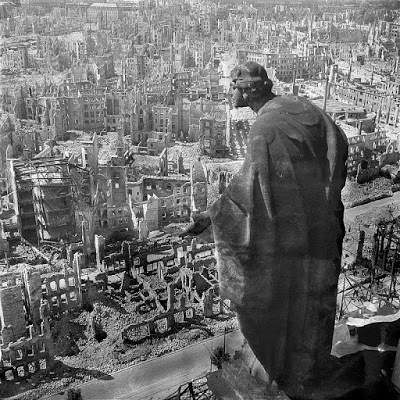
DESTRUCTION OF ANCIENT
DRESDEN in 1945
G'day folks,
February 13, 1945 — Waves of British bombers began reducing one of the world's most beautiful cities to rubble on this day. Thousands were to die in the ensuing firestorm as all-out war against Nazi Germany was intensified.
The bombing of Dresden in East Germany, a medieval city formerly renowned for its rich artistic and architectural treasures, remains controversial. The war was coming to an end with Hitler holed up in his Berlin bunker, the Russian Red Army racing towards the German capital from the east and the British and Americans advancing from the west.
Besides, many saw Dresden's contribution to the Nazi war effort as minimal, its defences were slight and the Russians would have had little trouble capturing the city. It seemed an unlikely target for a major attack.
But Air Chief Marshal Arthur Harris, head of Britain's Bomber Command and nicknamed "Bomber Harris", believed that any city that had anything to do with the Nazi war effort was a legitimate target.
On this night, 1,300 Royal Air Force Lancaster bombers descended on Dresden in two waves, dropping more than 1,400 tons of high-explosive bombs and more than 1,100 tons of incendiaries, destroying 90 per cent of the city and killing thousands of people. The city’s air defences were so weak that only six planes were shot down.
A massive firestorm developed over eight square miles engulfing the narrow, medieval streets. The more the city burned, the more oxygen was sucked in – and the greater the firestorm became. It is estimated that the temperature reached 1,800 deg Fahrenheit.
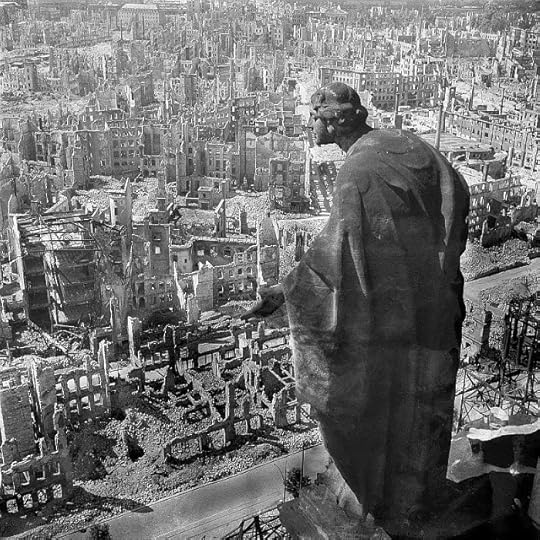
The following morning, as fire-fighters tried to tackle the inferno, 529 bombers of the USAAF (U.S. air force) attacked, causing even greater chaos. On February 15, another 200 U.S. bombers continued their assault on the city.
All told, bombers of the U.S. Eighth Air Force dropped more than 950 tons of high-explosive bombs and more than 290 tons of incendiaries on Dresden.
Given the high number of civilian casualties – estimates now ranging from 35,000 to 135,000 – and the relatively few strategic targets, some have called the bombing of Dresden a war crime. However, both the British and the American militaries defended the bombing as necessary.
It had been pointed out that Dresden was not simply a cultural centre – it had factories producing weapons and equipment for the war effort and its railway could send troops to the front for the fight against the Russians.
But many historians believe that one purpose of the devastating attack was to give a signal to Russia. The Russians were allies but Prime Minister Winston Churchilland U.S. President Franklin D. Roosevelt were uneasy about Josef Stalin's ambitions and post-war plans.
The reasoning went that the bombing of Dresden would show the Russians the awesome power of the Allies and act as a warning to Stalin not to stray from agreements he had made at war conferences.
An internal RAF memo dated a few weeks earlier seems to confirm this view. It said: “Dresden is the largest unbombed city the enemy has got.
"The intention of the attack is to hit the enemy where he will feel it most, behind an already partially collapsed front, to prevent the use of the city in the way of further advance – and incidentally to show the Russians when they arrive what Bomber Command can do.”
After reunification in 1990, Germany undertook extensive reconstruction of the city – work that is ongoing. Dresden has been restored to much of its former grandeur as a centre for art and culture.
Footnote: Germany dropped 35,000 tons of bombs on Britain over eight months in 1940-41, killing an estimated 39,000 people. In total, Britain and the U.S. dropped about 1.9 million tons of bombs on Germany over seven years. The number of civilian casualties is unknown because of the shifting population and widespread movement of refugees.

Clancy's comment: War sucks!
I'm ...


April 9, 2021
20 May 2021 - SOME FACTS ABOUT THEODORE ROOSEVELT
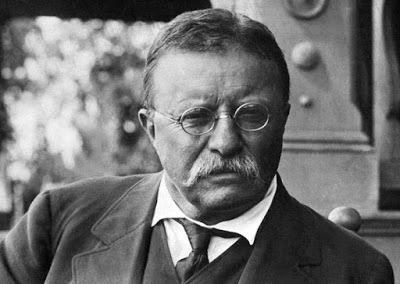
SOME FACTS ABOUT
THEODORE ROOSEVELT
G'day folks,
May 17, 1903 — President Theodore Rooseveltsat at a campfire with naturalist John Muir on this day and discussed conservation – a matter of deep concern to both men.
It was part of a three-night camping trip that helped shape Roosevelt’s conservation policies. During his presidency he placed 230 million acres of public land under government protection, including iconic landmarks such as the Yosemite Valley and the Grand Canyon.
He became a close friend of Muir who had written: “Only by going alone in silence, without baggage, can one truly get into the heart of the wilderness. All other travel is mere dust and hotels and baggage and chatter.”

Theodore was the first of the two Roosevelts to become President of the United States. Although born 24 years apart, he and Franklin D. Roosevelt had much in common. As well as being distant cousins, they both had wealthy parents, they both went to Harvard University and they both went to Columbia Law School.
But Theodore chalked up one achievement that his cousin could not match: he had the Teddy Bear named after him. It happened when, as President in 1902, he went on a hunting trip in Mississippi and was invited to shoot a bear that had been tied to a tree. Considering this cruel and unsportsmanlike, the President refused.
After reading a newspaper report of the incident a toy maker in New York created a stuffed bear which he named “Teddy’s Bear”, using Roosevelt’s nickname. It led to a “teddy bear” fad that swept across the nation and then the world.
Like Franklin, Theodore was a descendant of Dutch colonists who settled in America in the mid-17th century. He was born in New York City in 1858, his father being a glass importer and one of New York's leading philanthropists.
Theodore was a sickly child, suffering from asthma and to escape his health problems he exercised in a home gym. He also spent hours in his father’s library reading about wild animals, hunting trips and frontier adventure.
At the age of seven, enterprising Theodore created the “Roosevelt Museum of Natural History” and charged visitors one cent to view it in the parlour of the family home.
By now he was firmly gripped by a fascination with the great outdoors. Fast forward to Roosevelt in his 20s and his first hunting trip in the Dakota Territory. He ended up buying land and a ranch in what would become North Dakota.
It was here one day in 1886 that Roosevelt’s boat, moored outside his ranch, was stolen and taken down the Little Missouri River. The thieves obviously had no idea of the kind of man they were dealing with. Roosevelt and two ranch hands quickly built a replacement boat, then set off in pursuit.
Knowing the expedition could be long he packed essentials such as coffee and flour and also took a copy of Tolstoy’s Anna Karenina to read if there were any spare moments.
Roosevelt wrote about the episode later, revealing that it was late winter and the river had become icy and treacherous. But after three days of bumping along the water in freezing weather his group caught sight of their quarry.

They crept up on the thieves – who were armed – and apprehended them all on the river bank. The future president was angry about the theft of his boat but not enough to endanger the lives of the culprits.
Fearing that tying them up might cut off their circulation, he ordered the men to take off their boots. This was cactus country and without footwear the men would be going nowhere. Roosevelt spent the long journey back reading Anna Karenina.
While maintaining his passion for the Great Outdoors Roosevelt took a keen interest in politics and was elected as a Republican to the New York State Assembly at the age of 23. President William McKinleyappointed him Assistant Secretary of the Navy when he was 29.
But he did not stay long in the post because war was looming between the United States and Spain over Cuba and he wanted to fight. So Roosevelt resigned then helped organise the 1st Volunteer Cavalry, known as the Rough Riders, and led them into battle.
He emerged from the Spanish-American war as a national hero, became Governor of New York, then McKinley made him his running mate for the 1900 presidential re-election campaign, which they won.
All was to change the following year when an assassin shot and killed McKinley and Roosevelt, as Vice-President, automatically took over the White House. Six weeks short of his 43rd birthday, he was the youngest person ever to enter the presidency (although John F Kennedy, at 43, remains the youngest person to be ELECTED President).
Domestically, he promised the American people a “Square Deal” – “a square deal politically, a square deal in matters social and industrial.” He also took on powerful corporations and earned the nick-name of ‘trust-buster.’ “Our government, national and state, must be freed from the sinister influence or control of special interests,” he said, adding:
“Exactly as the special interests of cotton and slavery threatened our political integrity before the Civil War, so now the great special business interests too often control and corrupt the men and methods of government for their own profit. We must drive the special interests out of politics.”
Roosevelt established the US as a major player in world affairs, believing the right way to conduct foreign policy was to “speak softly and carry a big stick.” He mediated an end to the war between Russia and Japan, a triumph that earned him the Nobel Peace Prize.
But he considered his greatest accomplishment as President was helping Panama to secede from Columbia, leading to the construction by America of the Panama Canal, linking the Atlantic and Pacific oceans. It was seen as a symbol of American determination and technological know-how, taking ten years to build from 1904 to 1914.
Theodore Roosevelt was America’s first “cowboy President” and was happy to be photographed in a buckskin shirt, a gun at his side. Larger than life more than any other occupant of the White House, he had been an amateur boxer. He was the first American politician to learn judo. He was a rancher. During his honeymoon he scaled the Matterhorn, reaching its summit. And he joined an expedition to log data about an unchartered river in the Amazon.
He also produced many memorable quotes, not least his reflection on his presidency:
“I believe in a strong executive; I believe in power. While President, I have used every ounce of power there was in the office . . . I do not believe that any President ever had as thoroughly good a time as I have had, or has ever enjoyed himself as much.”
There was tragedy as well as the good times. On February 14, 1884 Roosevelt's mother died, then hours later, so did his wife of four years, Alice Lee. The former from typhoid, the latter from Bright's disease, a severe kidney ailment. At the time Roosevelt was 25 and he had a two-day-old daughter. He wrote in his diary: "The light has gone out of my life."
Like his father, Roosevelt’s youngest son Quentin enjoyed a scrap and served as a pilot in the United States Air Service in the First World War.
Tragically, as the conflict was nearing its end in 1918, 20-year-old Quentin’s plane was shot down in France and he was killed.
Six months later on January 6, 1919, sick with illness and grief over the loss of his favourite son, Theodore Rooseveltdied in his sleep. He was 60 years old.
Alongside George Washington, Thomas Jefferson and Abraham Lincoln, his features form one of the four presidents carved into the granite face of Mount Rushmore at the national memorial in South Dakota.

Clancy's comment: Another interesting president. Many thanks to Ray Setterfield, depicted in the photograph above.
I'm ...


April 7, 2021
19 May 2021 - THE FIRST MOVING IMAGES
[image error]
THE FIRST
MOVING IMAGES
G'day folks,
The late 19th century saw nascent motion picture technology develop at a rapid pace as cameras and other technology slowly became mainstream. One of the earliest attempts at a moving image was the result of a test by the film pioneer Eadweard Muybridge.
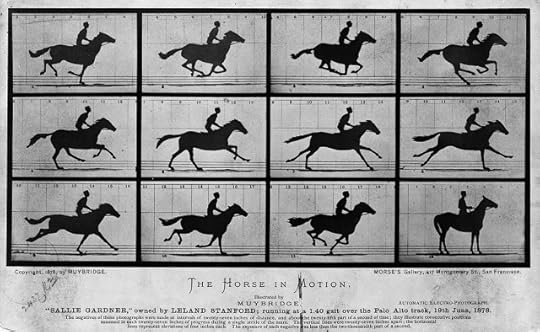
The purpose of the 24 rapidly taken photographs of a galloping horse was to see whether a horse lifts all four of its feet off the ground during a gallop, which human eyes cannot see at a certain speed. The images showed that a horse sometimes has all 4 feet off the ground simultaneously.
In 1880 Muybridge showed the images at the California School of Fine Arts - the first ever motion picture exhibition.
[image error]
Clancy's comment: There ya go.
I'm ...
[image error]
8 May 2021 - FIRST PHOTOGRAPH OF A HUMAN
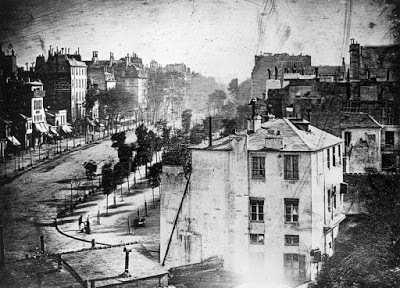
FIRST PHOTOGRAPH
OF A HUMAN
G'day folks,
In early 1838, Louis Daguerre used his famous daguerreotype process of photography to snap a photo of the Boulevard du Temple in Paris. The streets in the photo appear deserted: this is because the exposure time for the photo was so long that the cars and trams could not be captured.

Thus only the man having his shoes shined and the shoeshiner were motionless enough to be caught. This is thus the first known photograph of a person.
The daguerreotype was the first publicly available process of photography, announced in 1839, and for the following 20 years it was the most commonly used process.

Clancy's comment: Amazing. We have come a long way since then.
I'm ...


April 4, 2021
18 May 2021 - THE BEAUTY of MASTER POTTER WEDGWOOD
THE BEAUTY of
MASTER POTTER WEDGWOOD
G'day folks,
January 3, 1795 — When Josiah Wedgwood died on this day he left a thriving business and a fortune to his children. That’s because the pottery that he created was sought after across the world not only in palaces but also in humble homes.
It was also because Wedgwood stood out as a potter of genius, a remarkable businessman and extraordinarily innovative salesman.
Techniques often used today — direct mail, money-back guarantees, travelling salesmen, self-service, free delivery, buy one, get one free, illustrated catalogues — all came from Josiah Wedgwood.
Born in 1730, he was the youngest of Mary and Thomas Wedgwood’s twelve children. Thomas was a potter, as had been members of the family since the 17th century. It was Josiah's great-grandfather who started the family pottery business in 1656.
Early setbacks proved to be the making of Josiah. At the age of nine his father died and he had to abandon his formal school education to work in the family business.
He soon became an expert operator of the potter’s wheel, but contracted smallpox which caused a knee infection. It meant he was unable to work the wheel’s foot pedal.
Later in life the condition became so painful that Josiah had his right leg amputated just below the knee. At a time when there were no anaesthetics or even antiseptics, this was a brave decision by the budding entrepreneur, who obviously remained lame for the rest of his days.
But his enforced physical inactivity had given him the time him to read, research, and experiment in the craft of pottery.
As well as turning his attention to design, he set himself the task of producing a perfect glazed white body. Working tirelessly and refusing to be beaten, he finally succeeded after more than 400 experiments.
According to the Wedgwood website: “His interest in the properties of clays meant samples were sent to him from all over the world: Cherokee clay from America, Chinese kaolin and other rock from Canton, specimens from Australia, and others collected in the British Isles.”
His Jasperware, usually described as stoneware, has an unglazed matte "biscuit" finish and is produced in a number of different colours, of which the most common and best known is a pale blue that has become known as Wedgwood Blue.
After a time Josiah formed a partnership with Thomas Bentley, a former Liverpool merchant, and almost bursting with enthusiasm, Wedgwood wrote to him about his secret experiments:
"I am still going on with my tryals, & want much to shew you some of them, but I can neither send them in a letter, nor say so much about them to you as I could like, for Letters are liable to Accidents and therefore I must, though brim full, contain myself ’til I see you.”
The Wedgwood website goes on to give an insight into this remarkable man’s industry and determination: “Alongside these clay and mineral samples, Josiah's workbench would have held the objects which inspired him: antique vases and busts, waxes taken from ancient reliefs, half-finished pots, casts, biscuit ware and trial pieces.
“Josiah was indefatigable, developing new ceramic bodies, enlarging his factory, experimenting, expanding trade and nurturing his family. The letters he wrote, and the recording of his trials, experiments and ceramic work, was necessarily done, by candlelight, late at night or before dawn.”

In the end it all paid off. “Wedgwood’s enduring appeal among the world's royal families and heads of state began with Queen Charlotte [the wife of King George III], who ordered a set of cream-coloured earthernware. It pleased her so much that Josiah Wedgwood was granted permission to style himself 'Potter to Her Majesty' and call his innovative cream ware 'Queen's Ware’."
A few years later the Empress Catherine the Greatof Russia ordered a service in Queen's Ware for 50 people. It consisted of 952 hand-painted pieces of gardens, English scenery and stately homes and is on display today in the Hermitage Museum, St Petersburg.
While such expensive pottery was in much demand in high circles, Josiah made copies so that cheaper sets could be marketed to the rest of society. Before Catherine’s order was dispatched, for example, canny Josiah exhibited it in his showroom and, naturally, duplicate pieces were available for visitors to purchase.
Wedgwood was used on the banqueting tables at Queen Elizabeth II’s coronation in 1953, and a 1,282 piece dinner service graced President Roosevelt’s White House.
The success of his pottery enabled Josiah Wedgwood to build a new factory in 1768 equipped with tools and ovens of his own design which would allow mass production.
A philanthropist, Josiah built a village called Etruria for his workers next to the factory and improved roads, canals, schools and general living conditions. He named the complex after the Italian district of Etruria, home of the Etruscan people who were renowned for artistic products. The Wedgwood factory is now in Barlaston, a village about six miles to the south of the disused Etruria site.
* When Thomas Bentley died in 1780 Wedgwood turned to a friend, Erasmus Darwin, for help in running the business.
Darwin's son would later marry Josiah’s daughter Susannah, and they would become the parents of Charles Darwin, the naturalist who formulated the theory of evolution. Eventually, Charles would himself, in turn, marry his cousin Emma Wedgwood.

Clancy's comment: I also have some awesome pieces of this pottery. In fact, I used to buy it as wedding gifts because I knew the young couples would not be able to afford it.
I'm ...
[image error]

7 May 2021 - ANCIENT GLASS TREASURE SHATTERED BY DRUNK
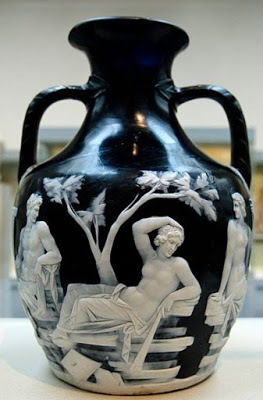
ANCIENT GLASS TREASURE
SHATTERED BY DRUNK
G'day folks,
February 7, 1845 — Unique, priceless and irreplaceable, the Portland Vase, thought to date back to the first century BC, was shattered into more than 80 pieces on this day. A drunken visitor to the British Museum threw a sculpted stone exhibit at the glass cabinet containing the treasured artefact.
The glass Roman vase, 24.5cm high, was discovered in a funerary monument in Rome in the 16th century. After belonging to several different owners it was acquired in 1784 by the Duchess of Portland, a noted collector of antiquities.
In 1810 the 4th Duke of Portland loaned the vase to the British Museum in London for permanent exhibition, where it was seemingly safe forever.
But neither the duke nor the museum had anticipated what would happen when William Lloyd paid a visit on this day. Apparently he had been drinking for several days and was well intoxicated when he hurled a sculpture at the glass case containing the Portland Vase.
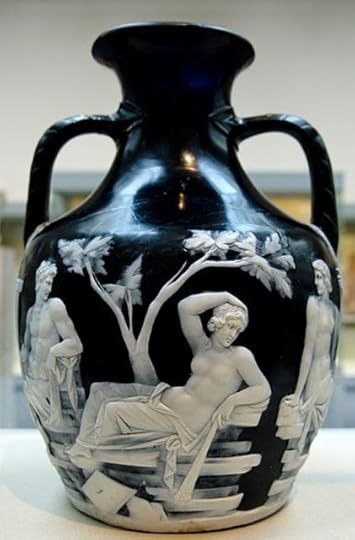
Lloyd, who said he was a student at Trinity College, Dublin, was arrested and later appeared in court charged with causing wilful damage. But his lawyers argued that the law under which he was being prosecuted applied only to the destruction of objects worth no more than five pounds.
As a result he was convicted only of destroying the glass case and was fined three pounds.
Investigations by the British Museum led, however, to a twist in the story. It was learned that although the vandal had been living in London under the name of William Lloyd, his real name was William Mulcahy. And although, as he claimed, he was a student, he had gone missing some time before from Trinity College.
Fortunately for him, the Duke of Portland decided not to bring a civil action for damages because he did not want Mulcahy’s impoverished family to suffer for “an act of folly or madness which they could not control”.
The British Museum bought the vase outright in 1945. It had been reconstructed in 1845 after the Mulcahy vandalism, but the work was only partly successful.
Another attempt was made in 1948 and a final restoration, using modern techniques, in 1988. The vase, back on display, now shows little sign of the original damage.

Clancy's comment: Brilliant restoration work.
I'm ...


April 2, 2021
17 May 2021 - STUNNING BALLPOINT PEN ART by ANDREY POLETAEV
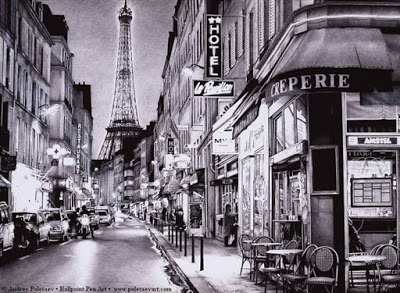
STUNNING BALLPOINT
PEN ART
by ANDREY POLETAEV
G'day folks,
Andrey Poletaev is a self-taught artist who specializes in ballpoint pen art and graphics. His work is technically complex and predominantly focuses on cityscapes. This art form is incredibly difficult to master, as mistakes are permanent. The complex detail found in cityscapes also make them incredibly time-consuming to complete. Nevertheless, the effect created when using ink in this way is nothing short of stunning when executed correctly. Take a look at Andrey's impressive works of art:

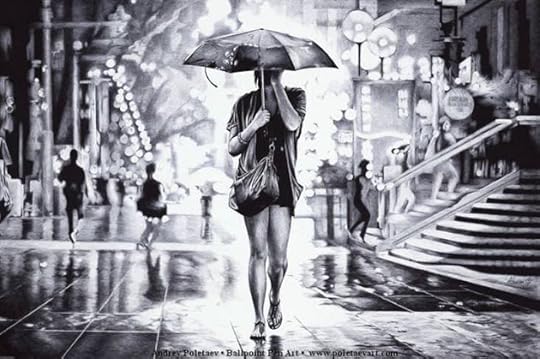


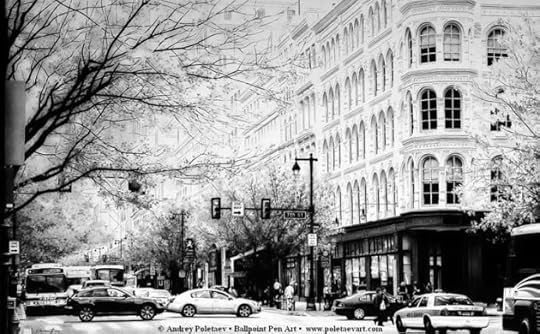
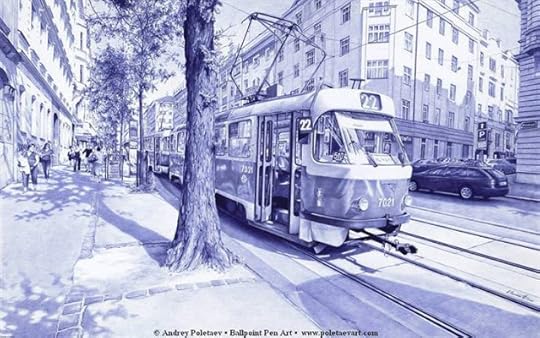

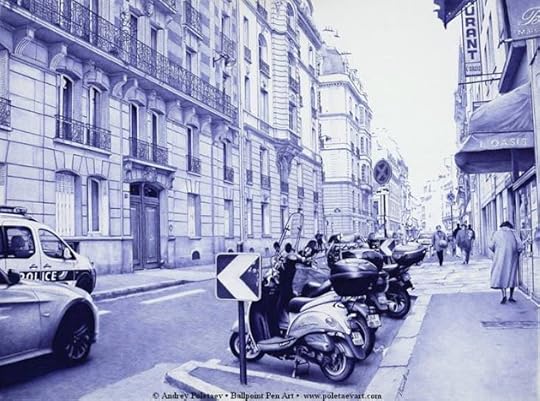




Clancy's comment: I have great admiration for people who can draw like this. Stunning!
I'm ...


April 1, 2021
11 May 2021 - ISAAC PITMAN - SHORTHAND INVENTOR

ISAAC PITMAN
- SHORTHAND INVENTOR -
G'day folks,
Today, many young people would have no idea what shorthand is.
January 22, 1897 — Isaac Pitman died on this day, leaving behind the shorthand note-taking system named after him, which became the most widely used in the English-speaking world. It continues to flourish despite astonishing advances in technology which would have been expected to render Pitman Shorthand obsolete.
Pitman was born in 1813, the third of his parents’ 11 children. His father, Samuel, was the manager of a weaving mill. Isaac went to a grammar school but left at the age of 13 because of health problems. He suffered with speech difficulties and the crowded classrooms frequently caused him to have fainting fits.
He took a job as a clerk at a textile mill but refused to give up his education and studied at home. It wasn’t long before he enrolled at a teacher’s training college, paving the way for an 11-year stint as a teacher at local schools.
While teaching English, he became fascinated by spelling and felt it needed reform. This led to his creation of Pitman Shorthand, a system of rapid writing based on the sounds of words – the phonetic principle – rather than on conventional spelling. It was all explained in a book, Stenographic Sound Hand, published in 1837.
Until his death at the age of 84, he continued to improve the system through twelve editions. He also established a phonetic institute and a phonetic journal to publicise it.
Not content with all that, Pitman also printed standard works in shorthand, and his book Phonography (1840) was published in many editions. The system quickly became widely popular and commercially successful.

Pitman shorthand was introduced into the United States in 1852. Among the many languages to which it has been adapted are Hindi, Hebrew, Arabic, Persian, German, French, Spanish, and Dutch.
In 1886 – eight years before he was knighted by Queen Victoria for his shorthand work – Pitman went into formal partnership with his sons Alfred and Ernest. Isaac Pitmanand Sons was to become one of the world's leading educational publishers and training businesses.
Now trading as Pitman Training, it continues to thrive from its base at Wetherby in Yorkshire. In 2013 it was recognised as a Superbrand in the prestigious league table that charts the UK’s strongest brands. Surprisingly perhaps, this put Pitman alongside such giants as Apple, Google and British Airways.
The company offers 250 courses and qualifications across a range of sectors including office, secretarial, book-keeping, web design and marketing. Teaching methods include audio, books and software.
As well as training centres in London, New York, Melbourne, Johannesburg, Toronto and Tokyo, it has 57 of them in the UK, 14 in Ireland, and others in Spain, Palestine, Romania, Kuwait, Ireland, Nigeria, Cayman Island, Zimbabwe and India.
But in this age of rapidly developing technology is there a future for shorthand? One blogger recently wrote: “As recording technology and voice recognition become more reliable, shorthand will be needed less and less. Laws will be changed to recognise recordings.
“Some reporters still find it useful, but most now use a recorder. In the UK, reporters still need shorthand at 100 words a minute, but there is increasing pressure to drop the requirement.”
However, former London newspaper executive Graham Dudman wrote in 2015: “The armoury of tools used by reporters to create journalism is changing as never before. Periscope, Instagram, Twitter … the list goes on.
“But among the all-singing, all-dancing hi-tech digital tricks and toys there is one old-fashioned tool still standing head and shoulders above the rest: shorthand. It has been top dog for decades and should remain so for decades to come.
“In my book, a reporter isn’t the finished article until they’ve passed their NCTJ [National Council for the Training of Journalists] shorthand at 100 words a minute.
“Why? Because the ability to write down what somebody says at the same time they’re saying it, then read your note back instantly is essential to do the job properly. Shorthand is a brilliant skill no digital trickery can match.”
You can almost hear applause from the ghost of Isaac Pitman.

Clancy's comment: I admire anyone who uses, or did use, shorthand.
I'm ...
